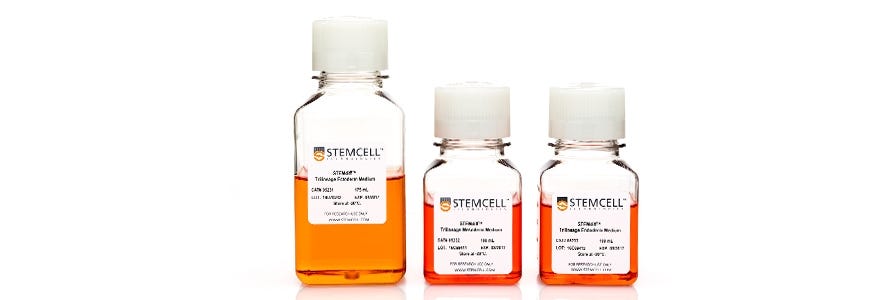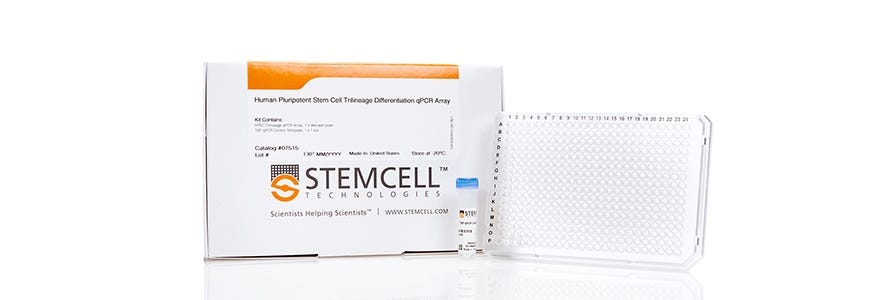Pluripotency
Human pluripotent stem cells (hPSCs) possess the unique ability to undergo the processes of self-renewal or differentiation into all somatic cell types derived from the embryonic germ layers: endoderm, mesoderm and ectoderm. hPSC potency can be evaluated using a number of strategies, of which the teratoma assay is the most widely-documented (Damjanov & Andrews, 2016). In this procedure, undifferentiated hPSCs are injected into an immunodeficient mouse, and develop into a heterogeneous tumor composed of terminally differentiated cells representative of all three germ layers. Unfortunately, this procedure can be lengthy, cost prohibitive and there is little consistency in the methodologies and analyses used (Bouma et al., 2017). As a result, alternative approaches to analyze hPSC potency are now being adopted.
When cultured in suspension, hPSCs spontaneously differentiate to form three-dimensional aggregates called embryoid bodies (EBs) (Itskovitz-Eldor et al., 2000). These structures recapitulate many features of cell differentiation during early embryogenesis and can display evidence of trilineage differentiation potential. Unfortunately, the EB assay has been difficult to standardize. Advances in protocols describing directed differentiation towards endoderm (D’Amour et al., 2005), mesoderm (Zhang et al., 2008) and ectoderm (Chambers et al., 2009) have provided researchers with the ease of use and specificity required in order to rapidly assess pluripotency.
It is important to note that common hPSC markers should be expressed by undifferentiated hPSCs, but are not necessarily markers of “pluripotency.” As a result, it is essential to go beyond measuring gene expression and validate the pluripotency of a hPSC line in a functional manner.
Key Publications
- This paper describes a highly efficient neural induction protocol using two inhibitors of SMAD signaling, Noggin and SB431542. Neural conversion of hPSCs is achieved using monolayer culture conditions as opposed to embryoid body formation.
Chambers SM et al. (2009) Highly efficient neural conversion of human ES and iPS cells by dual inhibition of SMAD signaling. Nat Biotechnol 27(3): 275-80. - D’Amour et al. describe an efficient protocol for the directed differentiation of hES cells to definitive endoderm. Homogeneous differentiation was achieved by the addition of activin A in low-serum conditions followed by CXCR4 enrichment.
D’Amour K et al. (2005) Efficient differentiation of human embryonic stem cells to definitive endoderm. Nat Biotechnol 23: 1534-41. - This atlas illustrates the microscopic features of tumors, or teratomas, produced from hPSCs xenografted into immunosuppressed mice.
Damjanov I & Andrews PW (2016) Teratomas produced from human pluripotent stem cells xenografted into immunodeficient mice - a histopathology atlas. Int J Dev Biol 60(10-11-12): 337-419.
On-Demand Webinars
Using CRISPR/Cas9 to Model Stem Cell Organization and Dynamics
View this webinar presentation by Dr. Ruwanthi Gunawardane, Director of Stem Cells and Gene Editing at the Allen Institute for Cell Science, who discussed the application of CRISPR/Cas9 to create a dynamic visual model of human induced pluripotent stem (hiPS) cell organization.

Allen Institute for Cell Science
- Creation of a dynamic visual model of hiPS cell organization through the endogenous labeling of major cellular organelles with a fluorescent protein
- Overview of the CRISPR/Cas9 methodologies used for endogenous gene tagging, screening for precise editing, and cell biological and genomic quality control
- An unprecedented clarity in live cell imaging provided by the endogenous tagging of hiPS cells
- Potential applications of the Allen Institute's hiPS cell lines for basic science and disease modeling
Allen Institute for Cell Science
Ruwanthi (Ru) Gunawardane, PhD, is the director of stem cells and gene editing at the Allen Institute for Cell Science, where a multi-disciplinary, team-science approach is used to study the fundamentals of cell behavior. Ru leads a group of researchers creating a collection of high-quality gene edited stem cell lines that are used by the institute to study cell organization and activities through live cell imaging and are also made available to the research community. Ru joined the Allen Institute after spending 5 years at Amgen, where she developed assays to screen for novel therapeutics in oncology, inflammation, and cardiovascular diseases and help advance the early drug discovery pipeline. Prior to Amgen, Ru worked at Ambit Biosciences as part of a small team of scientists that identified and characterized AC220, a potent FLT3 kinase inhibitor that is currently in phase 3 trials for AML. Ru obtained her PhD in Biology from Johns Hopkins University, where she studied microtubule nucleation in the Drosophila and Xenopus model systems. She conducted her postdoctoral work at the Harvard Medical School, where she studied cell migration and invasion in mammary epithelial cells using 3D tissue culture model systems as a model for breast cancer progression.
Highly Efficient Single-Cell Human Pluripotent Stem Cell Cloning and Robust Cardiomyocyte Differentiation
Recorded during the ISSCR 2017 Innovation Showcase in Boston, this tutorial highlights human pluripotent stem cell (hPSC) gene-editing and cardiac differentiation workflows using the CloneR™ supplement and the STEMdiff™ Cardiomyocyte System. This talk is presented by STEMCELL Technologies' Dr. Adam Hirst, scientist for pluripotent stem cell biology, and Dr. Vincenzo Macri, senior scientist for cardiomyocyte stem cell biology.

STEMCELL Technologies
STEMCELL Technologies
Adam Hirst completed his PhD in Stem Cell Biology from the University of Sheffield where his research focused on genomic instability in human pluripotent stem cells. He then worked as a Research Fellow at the University of Nottingham studying the specification of primordial germ cells in non-rodent mammals. Adam is currently a Scientist at STEMCELL Technologies, developing products to facilitate innovative techniques such as gene-editing in human pluripotent stem cells.
STEMCELL Technologies
Vincenzo Macri completed his PhD in Physiology from the University of British Columbia. He then worked as a Postdoctoral Research Fellow at Massachusetts General Hospital and Harvard Medical School. His research work focused on human genetics, cardiac arrhythmias, cellular electrophysiology, and cardiomyocyte stem cell biology, for which he received Postdoctoral Fellowship awards from the Heart Rhythm Society and Massachusetts General Hospital. Vincenzo is currently a Senior Scientist at STEMCELL Technologies, developing products to support cardiomyocyte stem cell biology research.
STEMdiff™ Kits for Robust and Efficient Differentiation of hPSCs to Multiple Cell Types
Dr. Melanie Kardel, scientist at STEMCELL Technologies, describes the use of STEMdiff™ kits to differentiate human pluripotent stem cells to all three germ layers. This video was filmed during the Innovation Showcase at ISSCR 2016 in San Francisco. Human pluripotent stem cells (hPSCs) have many applications in developmental biology studies, disease modeling, drug screening and regenerative medicine. Advancement in each of these areas requires robust and efficient differentiation methods to direct hPSCs to specific cell types of interest. STEMCELL Technologies’ STEMdiff™ kits are standardized reagents that are rigorously optimized for robust differentiation to specific cell types derived from the three germ layers: ectoderm, mesoderm and endoderm. In this video recorded during the Innovation Showcase at the ISSCR 2016 in San Francisco, Dr. Kardel will highlight the development of the most recent STEMdiff™ products. These include the STEMdiff™ Trilineage Differentiation Kit, a simple culture assay for rapid assessment of pluripotency, as well as new kits for directed differentiation to several mesodermal lineages: STEMdiff™ Mesoderm Induction Medium, STEMdiff™ Hematopoietic Kit and STEMdiff™ Mesenchymal Progenitor Kit. Finally, she will discuss the expansion of our endodermal-related STEMdiff™ system to include the STEMdiff™ Pancreatic Progenitor Kit. In summary, this tutorial will highlight STEMCELL Technologies’ expanding differentiation product portfolio for hPSC research.

STEMCELL Technologies
STEMCELL Technologies
Melanie Kardel is a Senior Scientist in the Pluripotent Stem Cell Biology team of the Research and Development Department at STEMCELL Technologies Inc. She obtained her PhD in genetics from the University of British Columbia and has a background in molecular genetics and cell biology, in particular, human embryonic stem cells and induced pluripotent stem cells. She completed her postdoctoral studies with Dr. Connie Eaves at the BC Cancer Agency in Vancouver, where she studied the differentiation of human pluripotent stem cells into hematopoietic progenitor cells. Since joining STEMCELL Technologies in 2012, her research areas include human pluripotent stem cell maintenance, characterization, and differentiation. Recently, she had led her team in the development of technologies to direct human pluripotent stem cell differentiation to hematopoietic cells.
Tools for Pluripotency Assessment

STEMdiff™ Trilineage Differentiation Kit
The STEMdiff™ Trilineage Differentiation Kit provides a simple culture assay to functionally validate the ability of new or established human embryonic stem (ES) and induced pluripotent stem (iPS) cell lines to differentiate to the three germ layers: ectoderm, mesoderm and endoderm.

Human Pluripotent Stem Cell Trilineage Differentiation qPCR Array
This qPCR array provides the gene expression profile of undifferentiated ES and iPS cells and their trilineage derivatives following in vitro directed or spontaneous differentiation, thereby validating the ability of a cell line to differentiate to the three germ layers.

